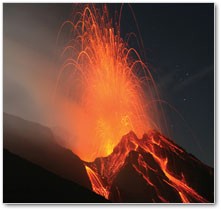Eruptive Disorder

By Terri Sota
New research on volcanic eruptions suggests that all that goes up does not necessarily come down. Explosions of halogen gases, most notably bromine and chlorine, are capable of reaching the stratosphere and damaging protective ozone. A GEOMAR study of 70,000 years of volcanic activity in Central America estimates that each of the 14 (examined) eruptions propelled 4,000 to 600,000 tons of bromine into the atmosphere and temporarily thinned the ozone layer.
Combining a mixture of existing atmospheric models, field work and geochemistry, researchers analyzed magma samples using high energy radiation to estimate the amount of gas before and after the eruptions. They calculated the difference between the two concentrations to arrive at the quantity of bromine and chlorine that was released.
What is the chemistry between these gases and ozone? Both chlorine and bromine are members of the Periodic Table’s Group VII â elements with seven electrons in their outer shells (eight is desirable for stability). At the first chance, these atoms will hijack electrons from passing ozone to enhance their stability. Just one chlorine atom has the power to destroy more than 100,000 ozone molecules. Thankfully, hydrogen chloride (the chlorine-containing compound prevalent in volcanic eruptions) dissolves readily in water and is usually deactivated by precipitation. Successful bans on chlorofluorocarbons (CFCs) have diminished human contributions and further reduced stratospheric chlorine levels.
For these reasons, scientists have nominated bromine as the halogen of the atmospheric research hour. While 100 times less abundant than chlorine in an eruption, bromine has 10X more ozone-depleting power. Other natural sources of the gas include ocean waters and brine wells, but it is the unpredictable, explosive delivery of the gas from volcanoes that warrants ongoing investigation. When Alaska’s Kasatochi Volcano erupted in August 2008, high bromine concentrations were detected by Europe’s first polar-orbiting satellite. One day after the eruption, instruments aboard the MetOp-A recorded 50 to 120 tons of reactive bromine in the atmosphere.
The authors of the study warn that tropical volcanoes have the ability to influence stratospheric chemistry all around the globe and deplete ozone over a widespread area. Continuing research will try to assess the damage done to the ozone in the past and predict the impact of volcanic gas activity in the future.
Classroom Discussion
- Discuss the behavioral differences of elements with varied numbers of outer shell electrons
- What are some of the other dangers posed by a volcanic eruption?